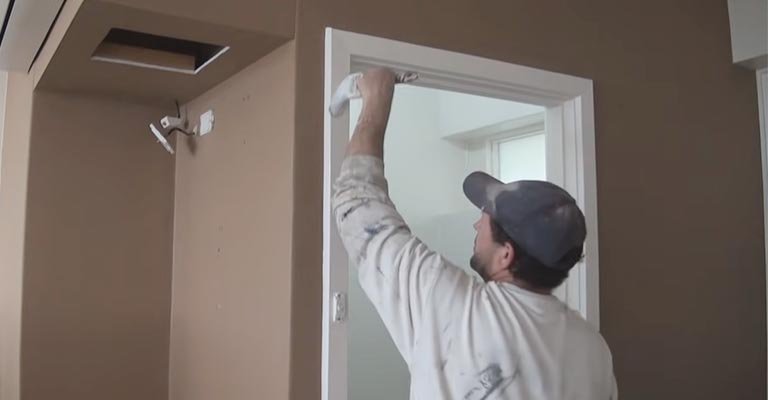
When you paint a door, the paint can create unwanted friction on the doorknob mechanism. It’s a bit like trying to squeeze into a dress one size too small; it just doesn’t fit right. There are several reasons your doorknob could be sticking, from paint overspray to moisture issues. Understanding these reasons can help you troubleshoot effectively and get your door working smoothly again. Ready to figure it out? Let’s go!
How Paint Affects Door Hardware
When you paint a door, the paint can inadvertently land on the doorknob and latch mechanism. This is especially true if you’re using a spray can or if you’re not careful with your brush strokes. The paint buildup can create friction, making it harder for the knob to turn.
Think of the doorknob as a spinning top. If you add extra weight—like paint—to it, the top struggles to spin freely. Just like that, a doorknob coated in paint can stick. The paint can find its way into the gap where the knob meets the door or even fill in the little recesses meant for the knob’s movement.
Over time, this can lead to more serious issues, like the doorknob becoming completely stuck. To avoid this, always be cautious and use painter’s tape to protect the hardware while painting.
Moisture and New Paint
Another reason your doorknob might be sticking after painting is moisture. Fresh paint takes time to dry completely. If you’ve painted your door recently, the moisture from the wet paint can cause the materials of the knob to swell, leading to a tight fit.
Here’s a quick analogy: picture a sponge soaking up water. Once it absorbs enough, it expands. Similarly, the components in your doorknob can expand due to excess moisture from the paint. If this is the case, all you need is patience. Allow the paint to dry fully, and the sticking should resolve itself.
However, if you painted your door during humid weather, this can increase drying time and exacerbate the sticking. In such situations, it’s best to check the weather conditions before starting your project and to ensure proper ventilation in the area as the paint dries.
Using the Wrong Paint Type
Sometimes, the paint itself can be the culprit. Using a paint that’s too thick or designed for outdoor use on an interior door can create problems. These types of paint can dry with a sticky residue or become tacky, leading to an even greater sticking problem with your doorknob.
Here’s the thing: not all paints are equal, and picking the right one matters. Interior paints are formulated to dry differently than exterior paints. When in doubt, always opt for a quality interior paint that offers a smoother finish. If you suspect the paint you used is too sticky, you might need to repaint with a more suitable option.
Hardware Misalignment
In some cases, the sticking might not be paint-related at all. It could be that your doorknob or latch is misaligned. When interior doors settle over time, the holes for the knob and latch can shift slightly. This misalignment can cause the knob to fit improperly, creating resistance when you try to turn it.
A simple fix is to check the alignment of the doorknob and latch. Make sure both pieces are securely attached and aligned with the holes in the door. If you notice any gaps or signs of misalignment, you might need to readjust the hardware. Loosening screws and repositioning the knob can do wonders for smooth operation.
Keeping Your Door Knob in Top Shape
To prevent problems in the future, consider these tips for maintaining your doorknob:
- Protect the Hardware: Use painter’s tape or plastic wrap to cover knobs and latches while painting.
- Choose the Right Paint: Stick to high-quality interior paints with a smooth finish.
- Regular Maintenance: Periodically check the hardware for tightness and alignment.
- Allow Time to Dry: Be patient; let the paint cure fully before testing the knob.
With proper care, your doorknob can work like a charm for years to come.
When to Ask for Help
If you’ve tried everything and your doorknob is still sticking, it might be time to call in a pro. Sometimes the issue may be more complicated than it seems. A qualified handyman or carpenter can assess the situation and may find underlying problems that need fixing, like door frame issues or hardware needing replacement.
You might also want to consider replacing the doorknob completely if it’s older or damaged. Newer models often come with better designs that help prevent these types of sticking issues in the future. Just think about how nice it would be to open your door without a fight!
Final Thoughts
Having a sticking doorknob after painting is more common than you think. Whether it’s due to paint buildup, moisture issues, or hardware misalignment, understanding the reasons can help you troubleshoot effectively and get your door working smoothly again.
Remember to take your time when painting, use the right materials, and regularly check your door hardware. If you encounter persistent problems, don’t hesitate to seek professional help. With a little effort, you’ll ensure that your interior doors operate seamlessly, making your home feel comfortable and welcoming. Happy decorating!